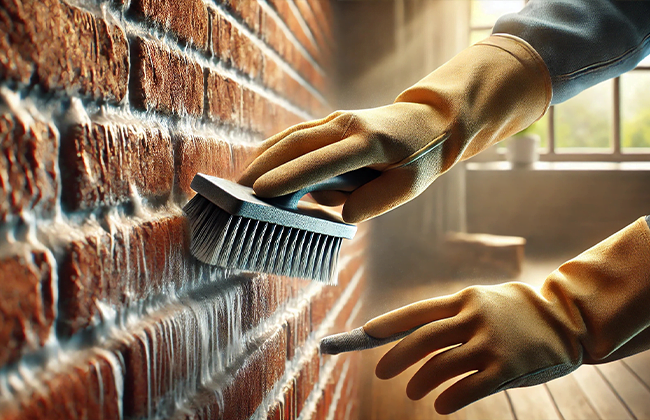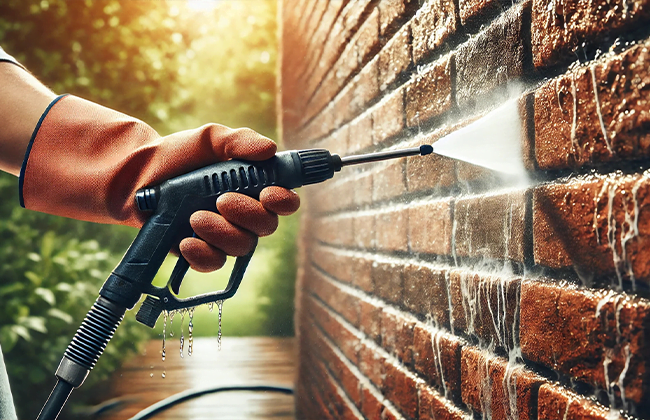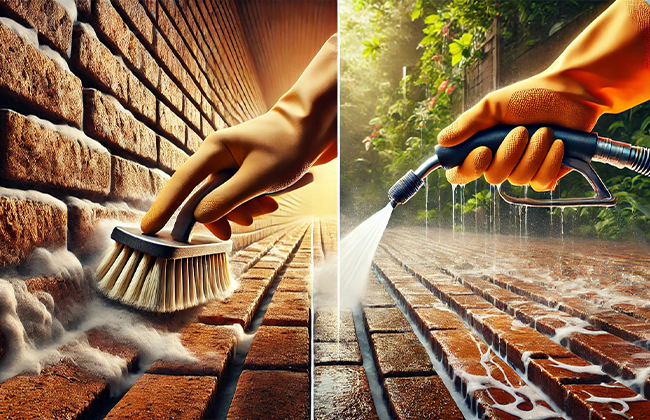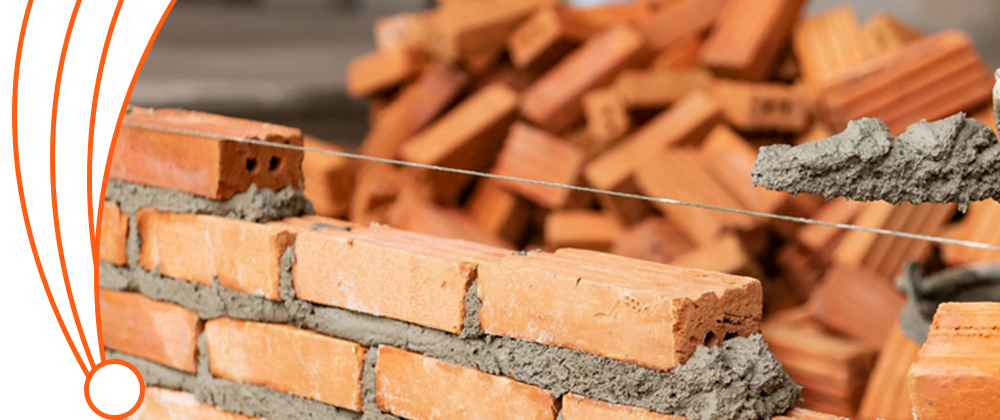Cleaning bricks can significantly enhance the appearance and longevity of your home. Knowing how to clean bricks properly is essential to maintain their structural integrity and aesthetic appeal. This guide provides detailed instructions and tips for effectively cleaning bricks both indoors and outdoors. By using the right tools and techniques, you can keep your bricks looking pristine and prevent long-term damage. Whether you’re dealing with dirt, stains, or biological growth, this guide will help you understand how to clean bricks effectively and efficiently.
Table of Contents
What is Indoor Brick Cleaning?

Indoor brick cleaning is about tackling the dirt, dust, and grime that build up on brick surfaces within your home or office. Unlike outdoor bricks, which face harsh weather conditions, indoor bricks often accumulate indoor air pollutants, including smoke and fine dust particles. To keep these bricks in good shape, it’s crucial to use cleaning methods that are effective yet gentle enough to preserve the integrity of the brick and mortar. Choosing the right tools and cleaning solutions is key, as harsh chemicals or abrasive scrubbing can do more harm than good. By understanding these factors, you can ensure your indoor bricks are not only clean but also well-maintained. Next, we’ll explore how to prepare for this cleaning task to maximize efficiency and protect your interior space.
Pre-Cleaning Preparations
Before you dive into the actual brick cleaning, taking a few preparatory steps can significantly enhance the effectiveness of your efforts and protect your indoor space. It’s not just about achieving clean bricks; it’s about maintaining the safety and integrity of your surrounding area.
- Clear the Area: Begin by removing any furniture and decor from the vicinity to ensure you have ample space to work. This step is crucial not only to provide you with easy access to the brick surfaces but also to safeguard your belongings from potential damage.
- Protect Sensitive Items: For items too cumbersome to move, such as large furniture or electronic appliances, cover them with protective sheets or tarps. Securing these coverings with tape can prevent them from shifting and offer better protection against spills and splatters.
- Prepare Your Cleaning Tools and Solutions: Organize all necessary cleaning tools and prepare your solutions beforehand. Having everything readily accessible not only makes the cleaning process smoother but also helps keep the area tidy and free from additional contaminants.
- Ensure Adequate Ventilation: Good ventilation is vital, especially if you’re using any chemical cleaners. Open windows or set up fans to keep the air moving, which aids in the drying process and dissipates any strong odors quickly.
With your space fully prepped, you’re ready to tackle the cleaning process head-on. Next, we’ll explore the various tools and cleaning solutions that will help you effectively clean your indoor bricks without damaging them. This upcoming section will guide you through selecting the right products and equipment to achieve optimal results.
Tools and Cleaning Solutions
Choosing the right tools and cleaning solutions is crucial when it comes to indoor brick cleaning. The goal here is not just to make the bricks look great but to do so without causing any harm to the brick or mortar.
Vacuums and Brushes:
Start with a good vacuum cleaner equipped with a soft brush attachment. This will help you remove any loose dust and debris from the surface of the bricks before you start the wet cleaning process. For more stubborn dirt, you’ll need a soft-bristled brush. Avoid using metal brushes or anything too abrasive, as these can scratch or damage the bricks and mortar.
Cleaning Solutions:
When it comes to choosing cleaning agents, it’s best to opt for mild soapy water for general cleaning. This can be made by mixing a small amount of dish soap with warm water. If you’re dealing with tougher stains, you might consider a specialized brick cleaning solution, but make sure it’s suitable for indoor use and non-abrasive. Always test any cleaning solution on a small, inconspicuous area of the brick first to ensure it doesn’t cause discoloration or damage.
Other Tools:
In addition to your vacuum and brushes, having a spray bottle can make applying your cleaning solution much easier and more uniform. For wiping down the bricks after cleaning, use soft, absorbent cloths or sponges that won’t leave residues behind.
Safety Gear:
Don’t forget personal protective equipment. While indoor cleaning solutions are generally gentler, it’s still a good idea to wear gloves to protect your hands, especially if you have sensitive skin or if you’re using stronger cleaning agents. Goggles can also be helpful to shield your eyes from splashing, particularly when working overhead.
With your tools and cleaning solutions ready, you’re all set to move on to the actual cleaning process. We’ll now dive into a step-by-step guide to cleaning your indoor bricks, ensuring that every nook and cranny is tackled effectively and safely. This next section will walk you through each phase of the cleaning, from applying your chosen solution to the final touches that will leave your bricks looking as good as new.
Step-by-Step Cleaning Process
Cleaning indoor bricks might seem daunting, but with the right approach, it can be quite straightforward and effective. Here’s how you can ensure a thorough clean without harming your brickwork:
Step 1: Dusting Off
Begin by thoroughly dusting the brick surface. Use your vacuum with a soft brush attachment to gently suck away any loose dust and debris. This initial step helps prepare the bricks for a more intensive clean, ensuring that the surface is free of loose particles that could scratch the bricks during scrubbing.
Step 2: Applying Cleaning Solution
Once dusting is complete, it’s time to apply your cleaning solution. If you’re using soapy water, fill a spray bottle with the mixture and evenly spray it over the brick surface. For tougher stains, a specialized brick cleaner might be necessary, but remember to keep it gentle and suitable for indoor use. Let the solution sit for a few minutes to break down the dirt and grime.
Step 3: Gentle Scrubbing
With the solution applied, take your soft-bristled brush and start scrubbing the bricks gently. Work in small sections, paying extra attention to stained areas. The key is to be thorough but gentle to avoid scratching the bricks or damaging the mortar.
Step 4: Rinsing
After scrubbing, gently rinse the bricks with clean water. Avoid using too much water, which can seep into the bricks and cause issues later. A damp cloth can be effective for wiping away the cleaning solution and any loosened dirt.
Step 5: Drying
Finally, ensure the bricks are dried thoroughly. You can let them air dry, or use clean, dry cloths to pat down the surface and absorb any remaining moisture. Proper drying is crucial to prevent any moisture-related damage or mold growth.
Finishing Touches:
Inspect the bricks after cleaning to make sure all areas are clean and there are no leftover residues. If necessary, a second light cleaning might be required for areas with persistent stains.
With these steps, your indoor bricks should not only be clean but also look revitalized. Keeping up with these cleaning steps can greatly extend the life and beauty of your brick surfaces. Now, let’s look at how to maintain these results with some routine maintenance tips, ensuring your bricks remain in top condition year-round.
Routine Maintenance Tips
Maintaining clean indoor bricks isn’t just about a one-time clean; it’s about setting up a routine that keeps your bricks looking their best all year round. Here’s how you can keep your indoor brick surfaces in pristine condition:
Frequency of Cleaning
Generally, it’s a good idea to schedule a thorough cleaning of your indoor bricks at least once a year. However, this can vary based on the location of the bricks and their exposure to dirt and pollutants. High-traffic areas or bricks near cooking zones may require more frequent cleaning, perhaps every six months.
Daily and Weekly Care
For day-to-day maintenance, a quick dusting or a wipe-down with a dry cloth can work wonders in keeping dust and debris at bay. If your bricks are in a kitchen or a similarly busy area, consider a weekly vacuum with a soft brush attachment to manage accumulations of grease or fine particles.
Dealing with Spills and Stains
When accidents happen, it’s best to address spills and stains immediately. The longer a spill sits, the harder it will be to remove. Use a damp cloth to dab at spills gently, avoiding harsh scrubbing, which can drive the stain deeper into the porous brick.
Special Considerations for Finished Bricks
If your bricks are sealed, painted, or treated in any way, make sure to use cleaning methods and products that are compatible with the finish. For sealed bricks, steer clear of abrasive cleaners and opt for pH-neutral solutions to avoid breaking down the sealant.
Regular Inspections
Part of routine maintenance also involves regularly inspecting your brickwork for any signs of damage or wear, such as cracks in the mortar or fading of finishes. Early detection can help you address minor issues before they escalate into major problems.
By integrating these maintenance tips into your regular cleaning routine, you can ensure that your indoor bricks remain not only clean but also in good condition. Now, as we’ve covered maintaining indoor bricks, let’s switch gears and explore what outdoor brick cleaning entails, diving into the specific challenges and methods suited for exterior brick care.
What is Outdoor Brick Cleaning?

Outdoor brick cleaning is crucial for removing the buildup of dirt, stains, and biological growth like moss and mildew that can detract from your home’s appearance and potentially damage the bricks over time. This cleaning process involves various techniques tailored to tackle the tough challenges posed by the outdoor environment. Whether it’s removing stubborn stains from driveways or gentle washing of decorative brick walls, the right approach ensures that your brickwork remains both visually appealing and structurally sound. As we delve into the specifics, we’ll explore the essential tools and methods that ensure effective cleaning while safeguarding your bricks against the harsh elements. Next, let’s take a closer look at the challenges faced by outdoor bricks, which will help us better understand why regular maintenance is so crucial.
Challenges Faced by Outdoor Bricks
Outdoor bricks face a unique set of challenges that can significantly affect their longevity and appearance. These challenges stem primarily from their constant exposure to diverse weather conditions and environmental factors.
- Weather Conditions: Outdoor bricks are subjected to the full range of weather elements, from scorching sun and heat to freezing cold and ice. Each condition affects the bricks differently. For example, prolonged exposure to sun can cause bricks to fade, while freezing temperatures can lead to frost damage where moisture has penetrated the bricks and then expanded as it freezes.
- Moisture and Biological Growth: Rain and humidity contribute to moisture accumulation, which is a primary culprit for biological growths like moss, algae, and mold. These growths not only mar the appearance of the brickwork but can also penetrate and weaken the mortar, leading to structural concerns over time.
- Pollution and Stains: Urban environments may expose bricks to pollutants and chemicals that can cause staining or gradual deterioration of the surface. Acid rain and industrial pollutants are particularly harsh on brick surfaces, necessitating more frequent and specialized cleaning to prevent permanent damage.
- Salt and Chemical Exposure: In coastal areas or places where road salt is used during winter, bricks can absorb these salts, which may lead to efflorescence or salt deposits on the surface. These deposits need to be carefully removed to prevent pitting and discoloration of the bricks.
Understanding these challenges is crucial for selecting the right cleaning techniques and products that effectively address these issues without damaging the bricks. With this knowledge, we can now turn our attention to the necessary equipment and safety measures that are essential for effectively tackling these outdoor brick cleaning tasks. This ensures not only the beauty but also the longevity of your brick structures.
Equipment and Safety Measures
When tackling the task of cleaning outdoor bricks, having the right equipment and adhering to safety measures is paramount. This not only ensures the job is done effectively but also safeguards you and your property during the process.
Pressure Washers:
A pressure washer is a vital tool for outdoor brick cleaning, capable of removing tough grime, stains, and biological growth. Choose a pressure washer with adjustable settings to control the water pressure, as too high pressure can damage the bricks and mortar.
Protective Gear:
Always wear appropriate protective gear when using a pressure washer or chemical cleaners. This includes safety goggles to protect your eyes from flying debris and chemical splashes. Use durable gloves to shield your hands from harsh cleaning agents, and ear protection if using a loud pressure washer.
Cleaning Agents:
Select cleaning agents that are effective yet mild enough not to damage the bricks. For most routine cleanings, a solution of water and mild detergent is sufficient. For tougher stains or biological growth, you may need specialized cleaning solutions formulated for outdoor use. Always follow the manufacturer’s instructions and test the cleaner on a small, inconspicuous area first to ensure it does not discolor or damage the bricks.
Additional Tools:
Besides a pressure washer, having a variety of brushes with soft to medium bristles can help in scrubbing areas where a pressure washer might be too intense. Long-handled brushes are particularly useful for reaching higher areas safely. For applying cleaners, consider using a pump sprayer to evenly distribute the cleaning solution across large areas.
Safety Tips:
When operating a pressure washer, ensure that you maintain a steady footing and handle the equipment with both hands. Keep children and pets away from the cleaning area to avoid accidents. Moreover, be mindful of your surroundings, especially windows, doors, and vehicles, to prevent damage from high-pressure water or chemical runoff.
By equipping yourself with these tools and adhering to safety measures, you’re ready to tackle any cleaning task your outdoor bricks might require. Up next, we’ll dive into “Effective Outdoor Brick Cleaning Techniques,” where we’ll explore specific methods and tips to ensure your bricks are not only clean but also maintained in a condition that stands the test of time.
Effective Outdoor Brick Cleaning Techniques
Cleaning outdoor bricks effectively requires a combination of the right techniques and careful handling. This ensures that the cleaning process does not damage the bricks or the surrounding areas.
Inspecting Bricks for Damage:
Before you begin cleaning, it’s crucial to inspect the brickwork for any signs of damage, such as cracks, loose bricks, or deteriorated mortar. Addressing these issues beforehand can prevent water from seeping into vulnerable areas during cleaning, which could potentially worsen the damage.
Applying Appropriate Cleaners:
Depending on the type of dirt and biological growth present, choose an appropriate cleaner. For general dirt, a mixture of water and mild detergent is often sufficient. For tougher stains like mold or moss, you might need a specialized brick cleaner that targets these issues without harming the brick’s surface. Always apply the cleaner using a spray bottle or a soft brush to ensure even coverage without saturating the bricks.
Using Pressure Washers Effectively:
When using a pressure washer, start with the lowest setting and gradually increase the pressure as needed. Maintain a safe distance of at least 12 inches from the surface and use a sweeping motion to avoid focusing the stream on one spot for too long. This technique helps prevent the mortar from being eroded by high-pressure water.
Methods for Thorough Rinsing:
After cleaning, thoroughly rinse the bricks to remove any leftover cleaner, which if left behind, could attract dirt or cause damage over time. Use clean water, preferably from a hose with a gentle spray setting, to wash away all residues. Ensure that the water flows down from the top to the bottom of the wall, mimicking natural rain. This helps clear the cleaner and debris effectively.
Checking the Results:
Once you’ve finished rinsing, take a step back and inspect the brickwork. Look for any areas that may have been missed or that still show signs of staining. In some cases, a second application of cleaner or another round of scrubbing may be necessary.
With these techniques, you’ll be able to clean your outdoor bricks effectively, preserving their beauty and structural integrity. Next, we’ll explore “Post-Cleaning Maintenance,” focusing on the steps you can take after cleaning to ensure your bricks remain in excellent condition for years to come.
Post-Cleaning Maintenance
After thoroughly cleaning your outdoor bricks, implementing effective post-cleaning maintenance strategies is crucial. This helps in extending their lifespan and preserving their aesthetic appeal. Here’s how you can keep your brickwork in top condition:
Sealing the Bricks:
Applying a sealant to your bricks can provide a protective layer. This helps prevent water absorption, staining, and damage from environmental factors. Choose a sealant that’s appropriate for your type of bricks and climate. For best results, ensure the bricks are completely dry before applying the sealant, and follow the manufacturer’s instructions for application. This usually involves applying the sealant evenly with a sprayer or roller and allowing it to cure for the recommended time.
Regular Maintenance Schedules:
Establish a routine maintenance schedule based on the environment and the usage of the area. For most homes, inspecting and cleaning the bricks annually is sufficient. However, in areas with high exposure to dirt, pollutants, or harsh weather, you might need to clean and inspect the bricks more frequently.
Monitoring for Damage:
Regularly check for any new signs of damage such as cracks, chips, or loose mortar. Early detection and repair of such issues can prevent more extensive and expensive repairs later on. If you notice small cracks or erosion in the mortar, consider repointing or patching these areas. This helps restore structural integrity and prevent further deterioration.
Cleaning Spills and Stains Promptly:
To prevent permanent staining, address spills and significant stains as soon as they occur. Using the appropriate cleaner for the type of stain can remove or minimize damage without the need for another full cleaning session.
Avoiding Harsh Chemicals:
For ongoing maintenance, avoid using harsh chemicals that can degrade brick and mortar over time. Stick to mild soaps and occasionally, diluted vinegar solutions for minor touch-ups and cleaning of new spills or stains.
By following these post-cleaning maintenance tips, you can ensure that your outdoor bricks not only look great immediately after cleaning. They will also remain in excellent condition for years to come. As you continue with regular upkeep, you might encounter specific cleaning challenges or need more advanced tips. Next, we’ll dive into “Advanced Cleaning Tips and Problem Solving,” where we’ll explore solutions to tackle unique or difficult brick cleaning scenarios effectively.
Advanced Tips for Clean Bricks and Problem Solving
Even with regular maintenance, you may encounter tough stains or unique challenges that require advanced cleaning techniques. Here’s how you can tackle these issues effectively, ensuring your bricks stay pristine without causing damage.
Dealing with Tough Stains:
For particularly stubborn stains like oil, paint, or rust, standard cleaning methods may not suffice. In such cases, a poultice made from a mixture of a specific solvent (like acetone for paint, or a degreaser for oil) and an absorbent material can be applied. Use an absorbent material like diatomaceous earth. This mixture is spread over the stain, covered with plastic to slow evaporation, and left to sit for 24 to 48 hours. The poultice draws out the stain into the absorbent material, making it easier to clean away without aggressive scrubbing.
Caring for Special Brick Types:
Historic or glazed bricks require special attention due to their age or the protective glaze finish. Avoid harsh chemicals and high-pressure washing. Instead, opt for gentle cleaning with pH-neutral solutions and soft brushes. Regular inspections are crucial to identify and address deterioration early, especially in historical structures.
Addressing Sensitive Areas:
Areas around doors, windows, and landscaping require careful handling to prevent water ingress or damage to adjacent materials. Use low-pressure settings when washing near these areas and consider hand cleaning with gentle tools around the most delicate zones.
Preventative Measures:
Applying a preventative approach can often reduce the need for intense cleaning sessions. For instance, installing gutters or diverting water runoff away from brick walls can minimize water stains and the accumulation of pollutants.
Professional Consultation:
When in doubt, or when dealing with particularly valuable or delicate brickwork, consult a professional. This can provide the expertise needed to tackle the problem without risking damage. This is especially important for historic buildings or when you encounter unfamiliar challenges.
By employing these advanced cleaning strategies, you can solve almost any problem that comes your way. This helps in preserving the integrity and appearance of your brick surfaces. As we conclude, let’s recap the key points. Reflect on how maintaining your bricks properly is integral to the long-term beauty and durability of your home or building.
Conclusion
In summary, learning how to clean bricks, both indoors and outdoors, is essential for maintaining the structural integrity and aesthetic value of your property. Regular maintenance and the right cleaning techniques ensure that your bricks remain in pristine condition over the years. If you’re looking for professional assistance with brick cleaning, whether it’s indoor or outdoor, don’t hesitate to reach out for expert help. For professional brick cleaning services, contact us at (+1) 917-355-8556. Our team is ready to provide you with the expertise and care your property deserves.
FAQs
Q: How to clean bricks with stubborn stains?
A: To clean bricks with stubborn stains, apply a poultice made from a suitable solvent and an absorbent material. Leave it for 24 to 48 hours to draw out the stain. This method is effective and avoids harsh scrubbing that can damage the bricks.
Q: What are the best tools for how to clean bricks?
A: The best tools for cleaning bricks include a pressure washer with adjustable settings. Soft-bristled brushes and a spray bottle for applying cleaning solutions are also essential. These tools ensure a thorough clean without damaging the brick surfaces.
Q: Can household items be used in how to clean bricks?
A: Yes, household items like mild dish soap, water, and soft brushes can be used to clean bricks. For tougher stains, a mixture of baking soda and water can be effective. Always test the solution on a small area first.
Q: How to clean bricks indoors without causing damage?
A: To clean bricks indoors, start by dusting with a vacuum and then apply a mild soapy water solution. Gently scrub with a soft-bristled brush and rinse with a damp cloth. This method ensures the bricks are cleaned without damage.
Q: How to clean bricks outdoors effectively?
A: For outdoor bricks, start by inspecting for damage, then apply a suitable cleaner. Use a pressure washer on a low setting and rinse thoroughly. This process effectively removes dirt and stains while protecting the brickwork.




